BFA605 Financial & Corporate Accounting: Leatherwood Trees Case
VerifiedAdded on 2023/04/08
|6
|1832
|80
Case Study
AI Summary
This document presents a solution to a case study that explores whether Tasmania's Leatherwood trees should be recognized as assets in financial accounting. The analysis considers the trees' significant contribution to the Tasmanian honey industry, which faced challenges due to recent bushfires. The solution delves into GAAP and International Accounting Standards, examining the criteria for asset recognition, including control, future economic benefits, and reliable measurement. It discusses the applicability of IAS 41 (Agriculture) to biological assets like the leatherwood trees, emphasizing fair value accounting and disclosures. The solution concludes that the trees should be recognized as assets due to their economic contribution to the state and alignment with accounting principles. The document also includes a discussion of heritage, cultural, and community assets and relevant references.
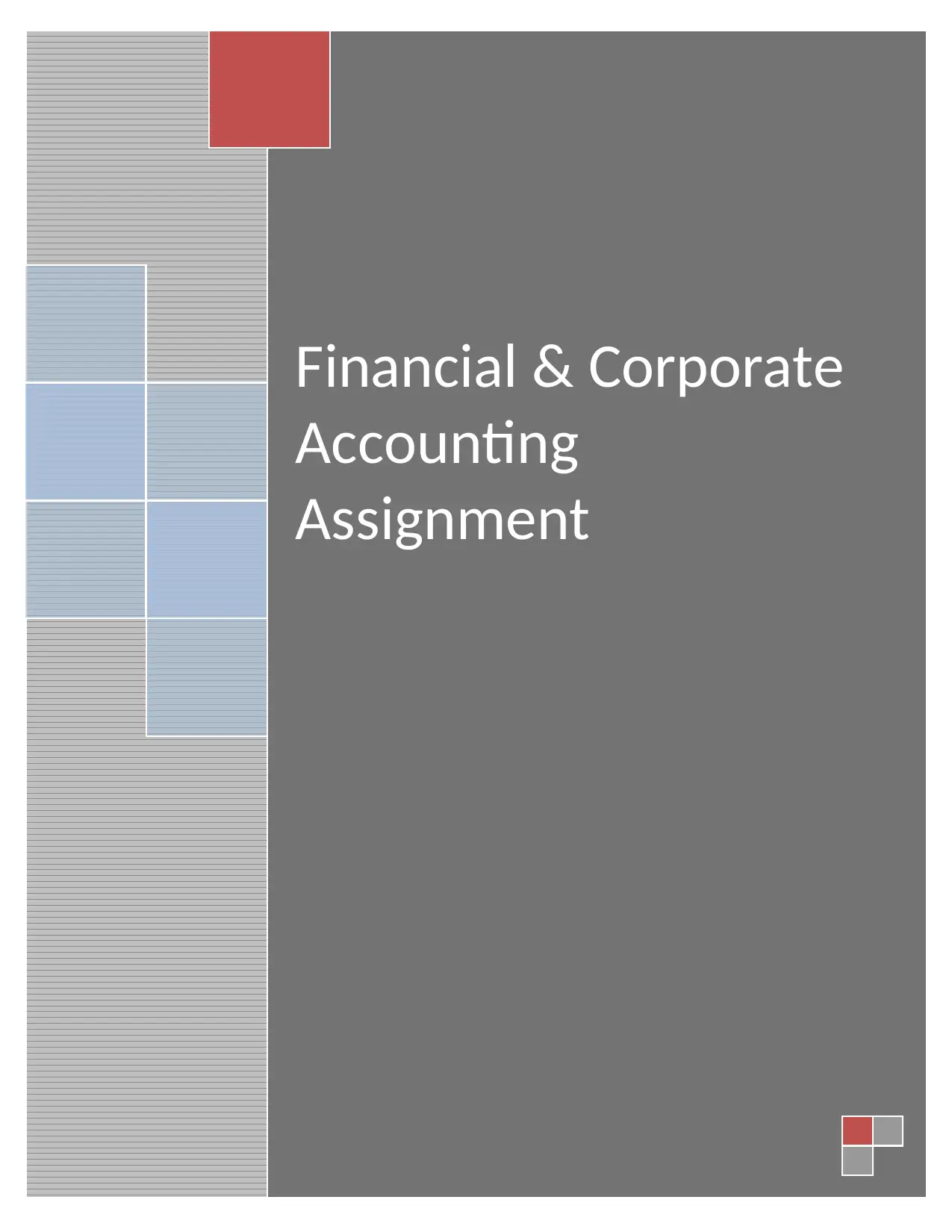
Financial & Corporate
Accounting
Assignment
Accounting
Assignment
Paraphrase This Document
Need a fresh take? Get an instant paraphrase of this document with our AI Paraphraser
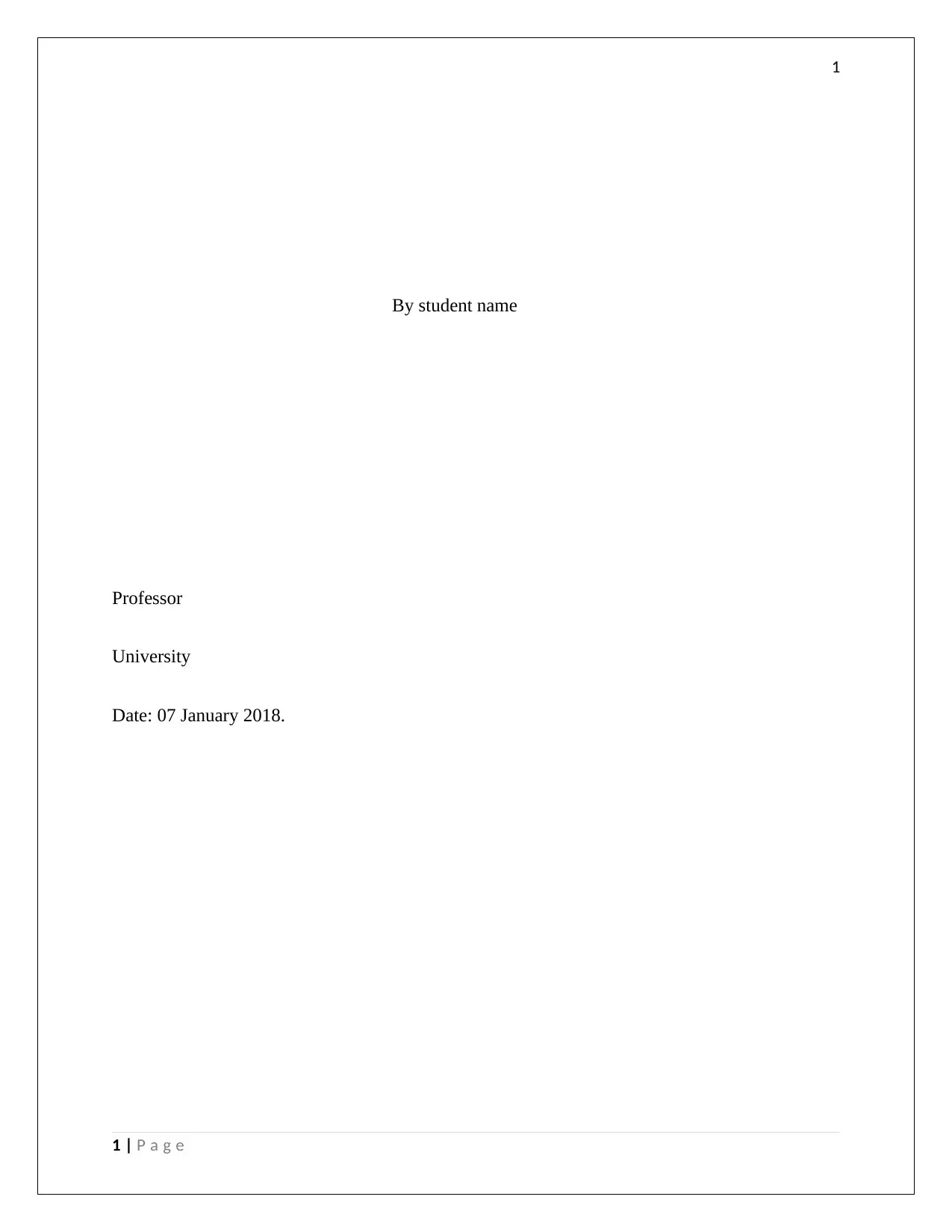
1
By student name
Professor
University
Date: 07 January 2018.
1 | P a g e
By student name
Professor
University
Date: 07 January 2018.
1 | P a g e
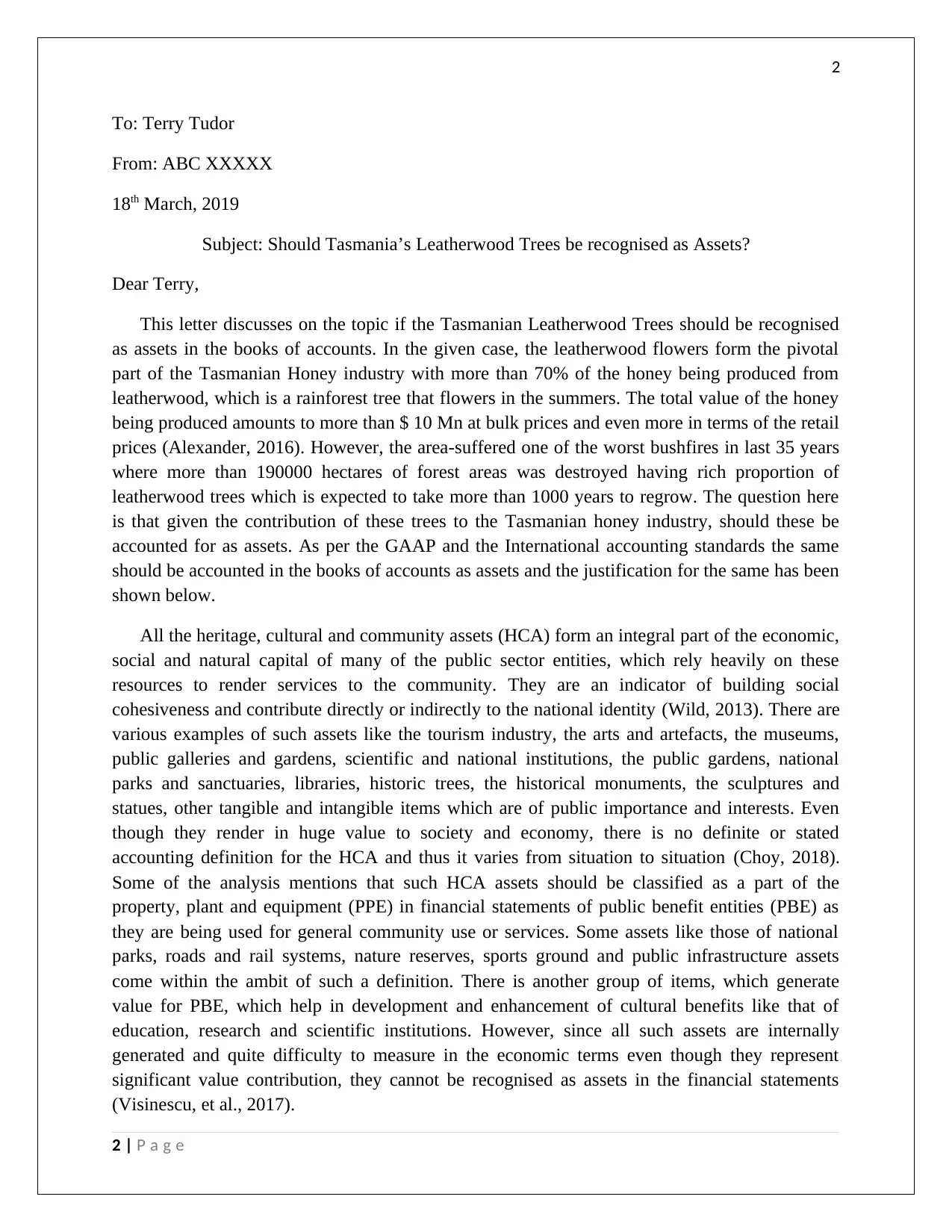
2
To: Terry Tudor
From: ABC XXXXX
18th March, 2019
Subject: Should Tasmania’s Leatherwood Trees be recognised as Assets?
Dear Terry,
This letter discusses on the topic if the Tasmanian Leatherwood Trees should be recognised
as assets in the books of accounts. In the given case, the leatherwood flowers form the pivotal
part of the Tasmanian Honey industry with more than 70% of the honey being produced from
leatherwood, which is a rainforest tree that flowers in the summers. The total value of the honey
being produced amounts to more than $ 10 Mn at bulk prices and even more in terms of the retail
prices (Alexander, 2016). However, the area-suffered one of the worst bushfires in last 35 years
where more than 190000 hectares of forest areas was destroyed having rich proportion of
leatherwood trees which is expected to take more than 1000 years to regrow. The question here
is that given the contribution of these trees to the Tasmanian honey industry, should these be
accounted for as assets. As per the GAAP and the International accounting standards the same
should be accounted in the books of accounts as assets and the justification for the same has been
shown below.
All the heritage, cultural and community assets (HCA) form an integral part of the economic,
social and natural capital of many of the public sector entities, which rely heavily on these
resources to render services to the community. They are an indicator of building social
cohesiveness and contribute directly or indirectly to the national identity (Wild, 2013). There are
various examples of such assets like the tourism industry, the arts and artefacts, the museums,
public galleries and gardens, scientific and national institutions, the public gardens, national
parks and sanctuaries, libraries, historic trees, the historical monuments, the sculptures and
statues, other tangible and intangible items which are of public importance and interests. Even
though they render in huge value to society and economy, there is no definite or stated
accounting definition for the HCA and thus it varies from situation to situation (Choy, 2018).
Some of the analysis mentions that such HCA assets should be classified as a part of the
property, plant and equipment (PPE) in financial statements of public benefit entities (PBE) as
they are being used for general community use or services. Some assets like those of national
parks, roads and rail systems, nature reserves, sports ground and public infrastructure assets
come within the ambit of such a definition. There is another group of items, which generate
value for PBE, which help in development and enhancement of cultural benefits like that of
education, research and scientific institutions. However, since all such assets are internally
generated and quite difficulty to measure in the economic terms even though they represent
significant value contribution, they cannot be recognised as assets in the financial statements
(Visinescu, et al., 2017).
2 | P a g e
To: Terry Tudor
From: ABC XXXXX
18th March, 2019
Subject: Should Tasmania’s Leatherwood Trees be recognised as Assets?
Dear Terry,
This letter discusses on the topic if the Tasmanian Leatherwood Trees should be recognised
as assets in the books of accounts. In the given case, the leatherwood flowers form the pivotal
part of the Tasmanian Honey industry with more than 70% of the honey being produced from
leatherwood, which is a rainforest tree that flowers in the summers. The total value of the honey
being produced amounts to more than $ 10 Mn at bulk prices and even more in terms of the retail
prices (Alexander, 2016). However, the area-suffered one of the worst bushfires in last 35 years
where more than 190000 hectares of forest areas was destroyed having rich proportion of
leatherwood trees which is expected to take more than 1000 years to regrow. The question here
is that given the contribution of these trees to the Tasmanian honey industry, should these be
accounted for as assets. As per the GAAP and the International accounting standards the same
should be accounted in the books of accounts as assets and the justification for the same has been
shown below.
All the heritage, cultural and community assets (HCA) form an integral part of the economic,
social and natural capital of many of the public sector entities, which rely heavily on these
resources to render services to the community. They are an indicator of building social
cohesiveness and contribute directly or indirectly to the national identity (Wild, 2013). There are
various examples of such assets like the tourism industry, the arts and artefacts, the museums,
public galleries and gardens, scientific and national institutions, the public gardens, national
parks and sanctuaries, libraries, historic trees, the historical monuments, the sculptures and
statues, other tangible and intangible items which are of public importance and interests. Even
though they render in huge value to society and economy, there is no definite or stated
accounting definition for the HCA and thus it varies from situation to situation (Choy, 2018).
Some of the analysis mentions that such HCA assets should be classified as a part of the
property, plant and equipment (PPE) in financial statements of public benefit entities (PBE) as
they are being used for general community use or services. Some assets like those of national
parks, roads and rail systems, nature reserves, sports ground and public infrastructure assets
come within the ambit of such a definition. There is another group of items, which generate
value for PBE, which help in development and enhancement of cultural benefits like that of
education, research and scientific institutions. However, since all such assets are internally
generated and quite difficulty to measure in the economic terms even though they represent
significant value contribution, they cannot be recognised as assets in the financial statements
(Visinescu, et al., 2017).
2 | P a g e
⊘ This is a preview!⊘
Do you want full access?
Subscribe today to unlock all pages.

Trusted by 1+ million students worldwide
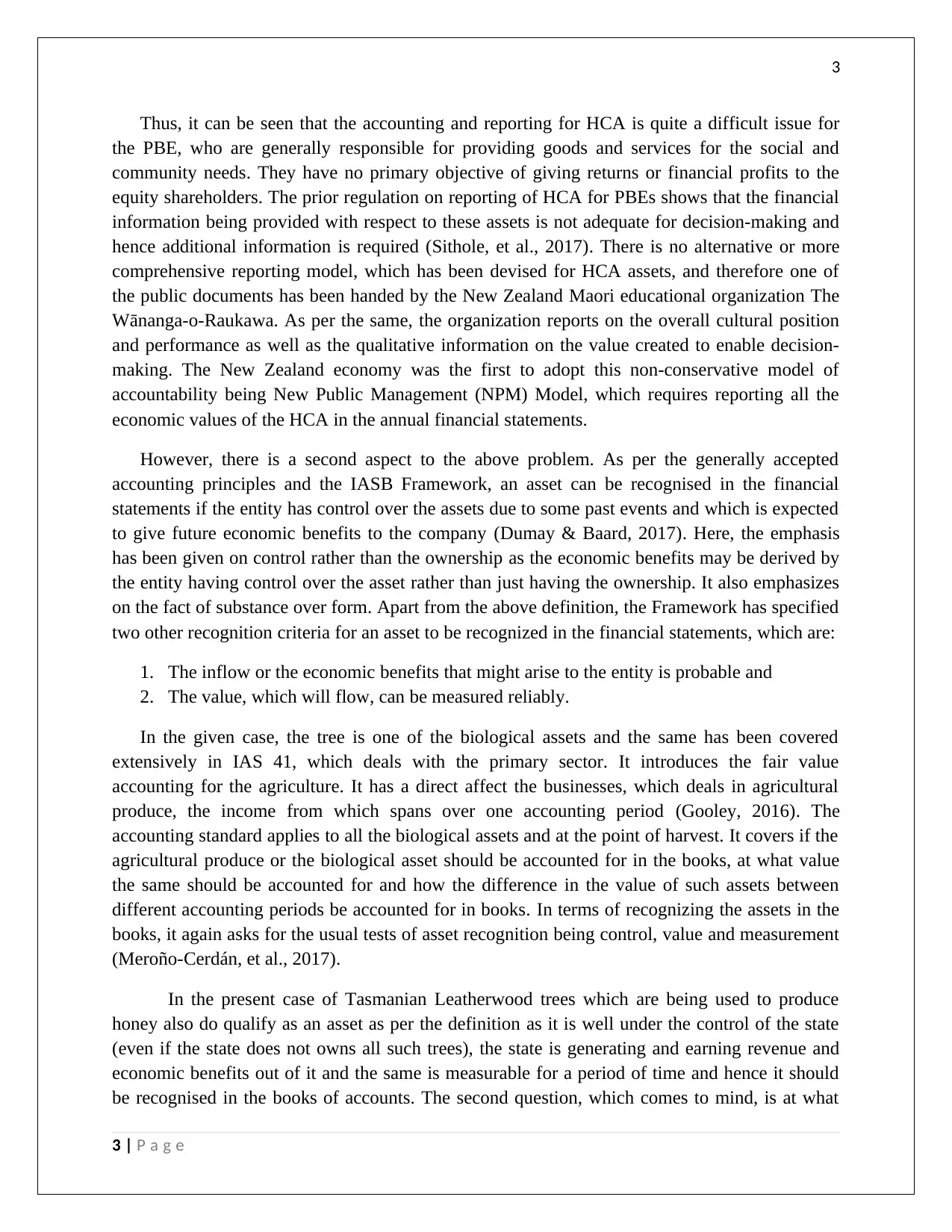
3
Thus, it can be seen that the accounting and reporting for HCA is quite a difficult issue for
the PBE, who are generally responsible for providing goods and services for the social and
community needs. They have no primary objective of giving returns or financial profits to the
equity shareholders. The prior regulation on reporting of HCA for PBEs shows that the financial
information being provided with respect to these assets is not adequate for decision-making and
hence additional information is required (Sithole, et al., 2017). There is no alternative or more
comprehensive reporting model, which has been devised for HCA assets, and therefore one of
the public documents has been handed by the New Zealand Maori educational organization The
Wānanga-o-Raukawa. As per the same, the organization reports on the overall cultural position
and performance as well as the qualitative information on the value created to enable decision-
making. The New Zealand economy was the first to adopt this non-conservative model of
accountability being New Public Management (NPM) Model, which requires reporting all the
economic values of the HCA in the annual financial statements.
However, there is a second aspect to the above problem. As per the generally accepted
accounting principles and the IASB Framework, an asset can be recognised in the financial
statements if the entity has control over the assets due to some past events and which is expected
to give future economic benefits to the company (Dumay & Baard, 2017). Here, the emphasis
has been given on control rather than the ownership as the economic benefits may be derived by
the entity having control over the asset rather than just having the ownership. It also emphasizes
on the fact of substance over form. Apart from the above definition, the Framework has specified
two other recognition criteria for an asset to be recognized in the financial statements, which are:
1. The inflow or the economic benefits that might arise to the entity is probable and
2. The value, which will flow, can be measured reliably.
In the given case, the tree is one of the biological assets and the same has been covered
extensively in IAS 41, which deals with the primary sector. It introduces the fair value
accounting for the agriculture. It has a direct affect the businesses, which deals in agricultural
produce, the income from which spans over one accounting period (Gooley, 2016). The
accounting standard applies to all the biological assets and at the point of harvest. It covers if the
agricultural produce or the biological asset should be accounted for in the books, at what value
the same should be accounted for and how the difference in the value of such assets between
different accounting periods be accounted for in books. In terms of recognizing the assets in the
books, it again asks for the usual tests of asset recognition being control, value and measurement
(Meroño-Cerdán, et al., 2017).
In the present case of Tasmanian Leatherwood trees which are being used to produce
honey also do qualify as an asset as per the definition as it is well under the control of the state
(even if the state does not owns all such trees), the state is generating and earning revenue and
economic benefits out of it and the same is measurable for a period of time and hence it should
be recognised in the books of accounts. The second question, which comes to mind, is at what
3 | P a g e
Thus, it can be seen that the accounting and reporting for HCA is quite a difficult issue for
the PBE, who are generally responsible for providing goods and services for the social and
community needs. They have no primary objective of giving returns or financial profits to the
equity shareholders. The prior regulation on reporting of HCA for PBEs shows that the financial
information being provided with respect to these assets is not adequate for decision-making and
hence additional information is required (Sithole, et al., 2017). There is no alternative or more
comprehensive reporting model, which has been devised for HCA assets, and therefore one of
the public documents has been handed by the New Zealand Maori educational organization The
Wānanga-o-Raukawa. As per the same, the organization reports on the overall cultural position
and performance as well as the qualitative information on the value created to enable decision-
making. The New Zealand economy was the first to adopt this non-conservative model of
accountability being New Public Management (NPM) Model, which requires reporting all the
economic values of the HCA in the annual financial statements.
However, there is a second aspect to the above problem. As per the generally accepted
accounting principles and the IASB Framework, an asset can be recognised in the financial
statements if the entity has control over the assets due to some past events and which is expected
to give future economic benefits to the company (Dumay & Baard, 2017). Here, the emphasis
has been given on control rather than the ownership as the economic benefits may be derived by
the entity having control over the asset rather than just having the ownership. It also emphasizes
on the fact of substance over form. Apart from the above definition, the Framework has specified
two other recognition criteria for an asset to be recognized in the financial statements, which are:
1. The inflow or the economic benefits that might arise to the entity is probable and
2. The value, which will flow, can be measured reliably.
In the given case, the tree is one of the biological assets and the same has been covered
extensively in IAS 41, which deals with the primary sector. It introduces the fair value
accounting for the agriculture. It has a direct affect the businesses, which deals in agricultural
produce, the income from which spans over one accounting period (Gooley, 2016). The
accounting standard applies to all the biological assets and at the point of harvest. It covers if the
agricultural produce or the biological asset should be accounted for in the books, at what value
the same should be accounted for and how the difference in the value of such assets between
different accounting periods be accounted for in books. In terms of recognizing the assets in the
books, it again asks for the usual tests of asset recognition being control, value and measurement
(Meroño-Cerdán, et al., 2017).
In the present case of Tasmanian Leatherwood trees which are being used to produce
honey also do qualify as an asset as per the definition as it is well under the control of the state
(even if the state does not owns all such trees), the state is generating and earning revenue and
economic benefits out of it and the same is measurable for a period of time and hence it should
be recognised in the books of accounts. The second question, which comes to mind, is at what
3 | P a g e
Paraphrase This Document
Need a fresh take? Get an instant paraphrase of this document with our AI Paraphraser
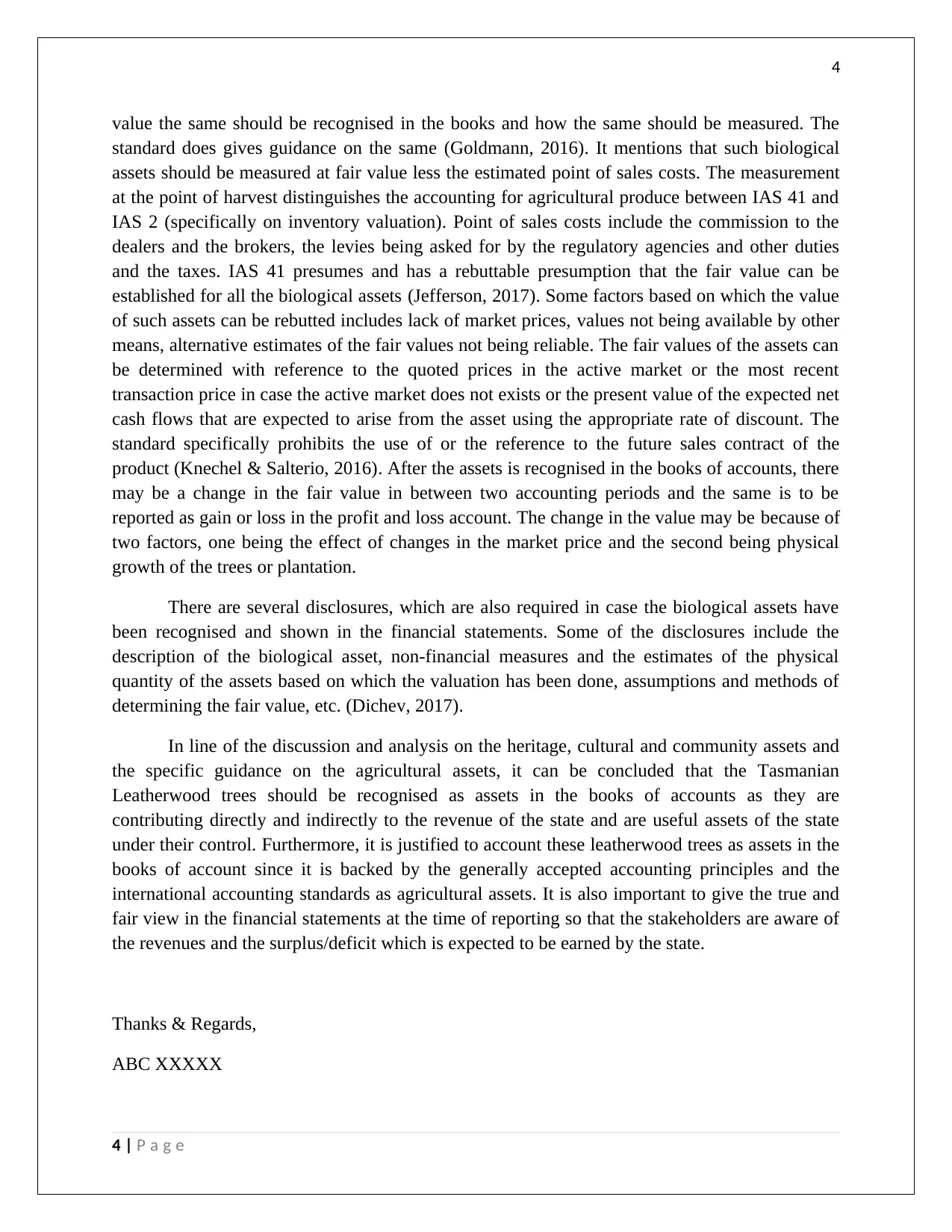
4
value the same should be recognised in the books and how the same should be measured. The
standard does gives guidance on the same (Goldmann, 2016). It mentions that such biological
assets should be measured at fair value less the estimated point of sales costs. The measurement
at the point of harvest distinguishes the accounting for agricultural produce between IAS 41 and
IAS 2 (specifically on inventory valuation). Point of sales costs include the commission to the
dealers and the brokers, the levies being asked for by the regulatory agencies and other duties
and the taxes. IAS 41 presumes and has a rebuttable presumption that the fair value can be
established for all the biological assets (Jefferson, 2017). Some factors based on which the value
of such assets can be rebutted includes lack of market prices, values not being available by other
means, alternative estimates of the fair values not being reliable. The fair values of the assets can
be determined with reference to the quoted prices in the active market or the most recent
transaction price in case the active market does not exists or the present value of the expected net
cash flows that are expected to arise from the asset using the appropriate rate of discount. The
standard specifically prohibits the use of or the reference to the future sales contract of the
product (Knechel & Salterio, 2016). After the assets is recognised in the books of accounts, there
may be a change in the fair value in between two accounting periods and the same is to be
reported as gain or loss in the profit and loss account. The change in the value may be because of
two factors, one being the effect of changes in the market price and the second being physical
growth of the trees or plantation.
There are several disclosures, which are also required in case the biological assets have
been recognised and shown in the financial statements. Some of the disclosures include the
description of the biological asset, non-financial measures and the estimates of the physical
quantity of the assets based on which the valuation has been done, assumptions and methods of
determining the fair value, etc. (Dichev, 2017).
In line of the discussion and analysis on the heritage, cultural and community assets and
the specific guidance on the agricultural assets, it can be concluded that the Tasmanian
Leatherwood trees should be recognised as assets in the books of accounts as they are
contributing directly and indirectly to the revenue of the state and are useful assets of the state
under their control. Furthermore, it is justified to account these leatherwood trees as assets in the
books of account since it is backed by the generally accepted accounting principles and the
international accounting standards as agricultural assets. It is also important to give the true and
fair view in the financial statements at the time of reporting so that the stakeholders are aware of
the revenues and the surplus/deficit which is expected to be earned by the state.
Thanks & Regards,
ABC XXXXX
4 | P a g e
value the same should be recognised in the books and how the same should be measured. The
standard does gives guidance on the same (Goldmann, 2016). It mentions that such biological
assets should be measured at fair value less the estimated point of sales costs. The measurement
at the point of harvest distinguishes the accounting for agricultural produce between IAS 41 and
IAS 2 (specifically on inventory valuation). Point of sales costs include the commission to the
dealers and the brokers, the levies being asked for by the regulatory agencies and other duties
and the taxes. IAS 41 presumes and has a rebuttable presumption that the fair value can be
established for all the biological assets (Jefferson, 2017). Some factors based on which the value
of such assets can be rebutted includes lack of market prices, values not being available by other
means, alternative estimates of the fair values not being reliable. The fair values of the assets can
be determined with reference to the quoted prices in the active market or the most recent
transaction price in case the active market does not exists or the present value of the expected net
cash flows that are expected to arise from the asset using the appropriate rate of discount. The
standard specifically prohibits the use of or the reference to the future sales contract of the
product (Knechel & Salterio, 2016). After the assets is recognised in the books of accounts, there
may be a change in the fair value in between two accounting periods and the same is to be
reported as gain or loss in the profit and loss account. The change in the value may be because of
two factors, one being the effect of changes in the market price and the second being physical
growth of the trees or plantation.
There are several disclosures, which are also required in case the biological assets have
been recognised and shown in the financial statements. Some of the disclosures include the
description of the biological asset, non-financial measures and the estimates of the physical
quantity of the assets based on which the valuation has been done, assumptions and methods of
determining the fair value, etc. (Dichev, 2017).
In line of the discussion and analysis on the heritage, cultural and community assets and
the specific guidance on the agricultural assets, it can be concluded that the Tasmanian
Leatherwood trees should be recognised as assets in the books of accounts as they are
contributing directly and indirectly to the revenue of the state and are useful assets of the state
under their control. Furthermore, it is justified to account these leatherwood trees as assets in the
books of account since it is backed by the generally accepted accounting principles and the
international accounting standards as agricultural assets. It is also important to give the true and
fair view in the financial statements at the time of reporting so that the stakeholders are aware of
the revenues and the surplus/deficit which is expected to be earned by the state.
Thanks & Regards,
ABC XXXXX
4 | P a g e
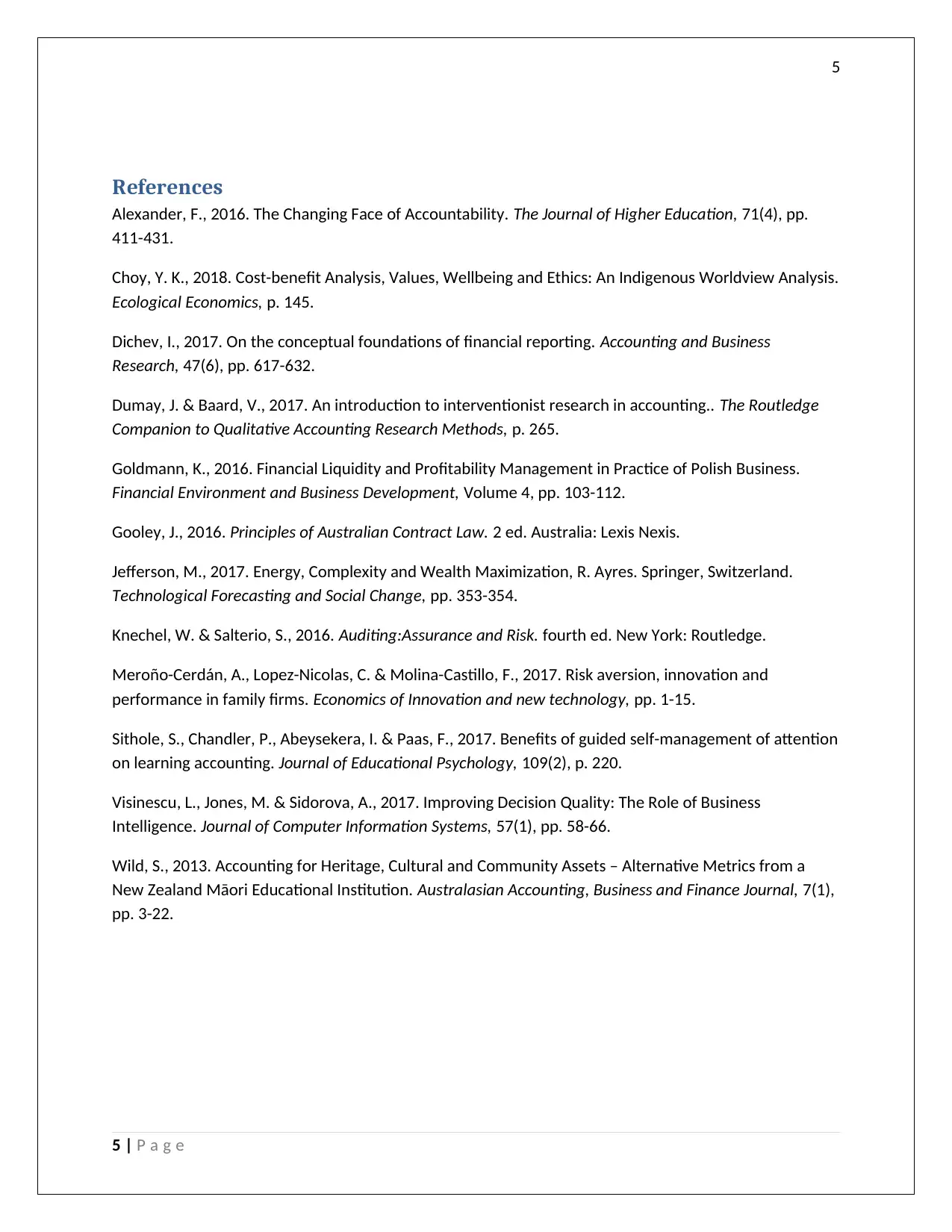
5
References
Alexander, F., 2016. The Changing Face of Accountability. The Journal of Higher Education, 71(4), pp.
411-431.
Choy, Y. K., 2018. Cost-benefit Analysis, Values, Wellbeing and Ethics: An Indigenous Worldview Analysis.
Ecological Economics, p. 145.
Dichev, I., 2017. On the conceptual foundations of financial reporting. Accounting and Business
Research, 47(6), pp. 617-632.
Dumay, J. & Baard, V., 2017. An introduction to interventionist research in accounting.. The Routledge
Companion to Qualitative Accounting Research Methods, p. 265.
Goldmann, K., 2016. Financial Liquidity and Profitability Management in Practice of Polish Business.
Financial Environment and Business Development, Volume 4, pp. 103-112.
Gooley, J., 2016. Principles of Australian Contract Law. 2 ed. Australia: Lexis Nexis.
Jefferson, M., 2017. Energy, Complexity and Wealth Maximization, R. Ayres. Springer, Switzerland.
Technological Forecasting and Social Change, pp. 353-354.
Knechel, W. & Salterio, S., 2016. Auditing:Assurance and Risk. fourth ed. New York: Routledge.
Meroño-Cerdán, A., Lopez-Nicolas, C. & Molina-Castillo, F., 2017. Risk aversion, innovation and
performance in family firms. Economics of Innovation and new technology, pp. 1-15.
Sithole, S., Chandler, P., Abeysekera, I. & Paas, F., 2017. Benefits of guided self-management of attention
on learning accounting. Journal of Educational Psychology, 109(2), p. 220.
Visinescu, L., Jones, M. & Sidorova, A., 2017. Improving Decision Quality: The Role of Business
Intelligence. Journal of Computer Information Systems, 57(1), pp. 58-66.
Wild, S., 2013. Accounting for Heritage, Cultural and Community Assets – Alternative Metrics from a
New Zealand Māori Educational Institution. Australasian Accounting, Business and Finance Journal, 7(1),
pp. 3-22.
5 | P a g e
References
Alexander, F., 2016. The Changing Face of Accountability. The Journal of Higher Education, 71(4), pp.
411-431.
Choy, Y. K., 2018. Cost-benefit Analysis, Values, Wellbeing and Ethics: An Indigenous Worldview Analysis.
Ecological Economics, p. 145.
Dichev, I., 2017. On the conceptual foundations of financial reporting. Accounting and Business
Research, 47(6), pp. 617-632.
Dumay, J. & Baard, V., 2017. An introduction to interventionist research in accounting.. The Routledge
Companion to Qualitative Accounting Research Methods, p. 265.
Goldmann, K., 2016. Financial Liquidity and Profitability Management in Practice of Polish Business.
Financial Environment and Business Development, Volume 4, pp. 103-112.
Gooley, J., 2016. Principles of Australian Contract Law. 2 ed. Australia: Lexis Nexis.
Jefferson, M., 2017. Energy, Complexity and Wealth Maximization, R. Ayres. Springer, Switzerland.
Technological Forecasting and Social Change, pp. 353-354.
Knechel, W. & Salterio, S., 2016. Auditing:Assurance and Risk. fourth ed. New York: Routledge.
Meroño-Cerdán, A., Lopez-Nicolas, C. & Molina-Castillo, F., 2017. Risk aversion, innovation and
performance in family firms. Economics of Innovation and new technology, pp. 1-15.
Sithole, S., Chandler, P., Abeysekera, I. & Paas, F., 2017. Benefits of guided self-management of attention
on learning accounting. Journal of Educational Psychology, 109(2), p. 220.
Visinescu, L., Jones, M. & Sidorova, A., 2017. Improving Decision Quality: The Role of Business
Intelligence. Journal of Computer Information Systems, 57(1), pp. 58-66.
Wild, S., 2013. Accounting for Heritage, Cultural and Community Assets – Alternative Metrics from a
New Zealand Māori Educational Institution. Australasian Accounting, Business and Finance Journal, 7(1),
pp. 3-22.
5 | P a g e
⊘ This is a preview!⊘
Do you want full access?
Subscribe today to unlock all pages.

Trusted by 1+ million students worldwide
1 out of 6
Your All-in-One AI-Powered Toolkit for Academic Success.
+13062052269
info@desklib.com
Available 24*7 on WhatsApp / Email
![[object Object]](/_next/static/media/star-bottom.7253800d.svg)
Unlock your academic potential
Copyright © 2020–2025 A2Z Services. All Rights Reserved. Developed and managed by ZUCOL.

